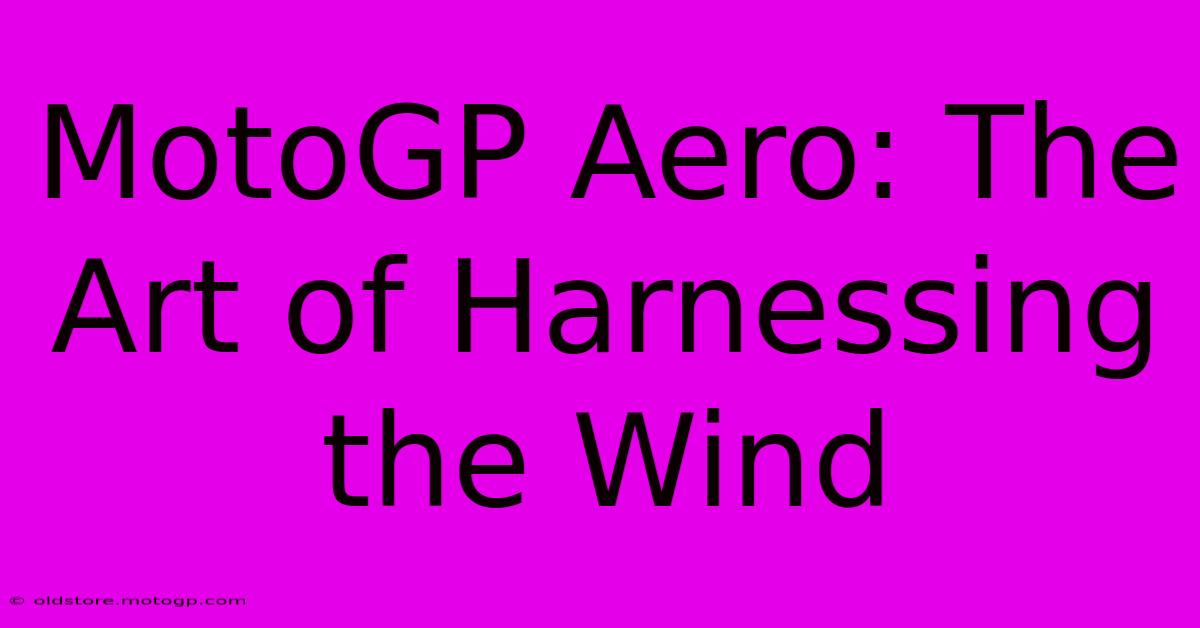MotoGP Aero: The Art Of Harnessing The Wind

Table of Contents
MotoGP Aero: The Art of Harnessing the Wind
MotoGP racing isn't just about powerful engines and skilled riders; it's a finely tuned dance between machine and environment. A crucial element in this dance is aerodynamics, or MotoGP aero. The art of harnessing the wind has become increasingly sophisticated, transforming from a minor consideration to a major factor determining race wins. This article delves into the complex world of MotoGP aerodynamics, exploring its evolution, its impact on performance, and the future of wind-tunnel technology in the sport.
The Evolution of MotoGP Aerodynamics
Early MotoGP bikes were relatively simple aerodynamically. While wind resistance was always a factor, the focus was primarily on engine power and rider skill. However, as speeds increased, the importance of aerodynamic efficiency became undeniable. The first noticeable aerodynamic additions were small fairings and spoilers, primarily designed to reduce drag.
From Basic Fairings to Complex Wings
Over the years, MotoGP aero has undergone a dramatic transformation. The introduction of winglets, small aerodynamic surfaces attached to the front fairing, marked a significant turning point. These winglets generate downforce, pushing the bike towards the track, improving stability at high speeds and enabling harder braking. This allowed riders to carry more speed through corners, leading to faster lap times.
The Rise of Sophisticated Aerodynamic Packages
Modern MotoGP bikes feature incredibly sophisticated aerodynamic packages. These include not only winglets but also larger wings, carefully designed fairings, and even aerodynamic appendages on the swingarm. These components work in concert to manage airflow around the bike, reducing drag, generating downforce, and improving stability in various riding conditions. The complexity of these designs reflects the intense competition and the pursuit of even marginal performance gains.
The Impact of Aerodynamics on MotoGP Performance
The impact of MotoGP aero on performance is multifaceted:
Increased Cornering Speeds
The most significant impact is the ability to corner faster. The increased downforce generated by aerodynamic components allows riders to maintain higher speeds through corners, shaving precious seconds off their lap times. This is crucial in a sport where milliseconds can decide the outcome of a race.
Enhanced Stability and Control
Improved stability at high speeds is another major benefit. Downforce keeps the bike planted on the track, giving the rider more control and confidence, especially during braking and acceleration. This translates to smoother, more consistent performance throughout the race.
Reduced Drag and Improved Top Speed
While generating downforce, effective aerodynamic design also focuses on minimizing drag. Reducing drag improves top speed and allows for better acceleration out of corners, further contributing to faster lap times. The balance between downforce and drag is a crucial design consideration.
The Future of MotoGP Aero: Wind Tunnel Technology and Beyond
The continuous quest for aerodynamic advantage drives innovation in MotoGP. Sophisticated wind tunnel testing plays a pivotal role in this process. Teams use advanced Computational Fluid Dynamics (CFD) simulations and state-of-the-art wind tunnels to refine their designs and optimize aerodynamic performance.
Advanced Simulation and Testing
Future developments in MotoGP aero are likely to involve even more sophisticated simulations and testing methodologies. This includes the use of advanced sensors and data acquisition systems to monitor airflow around the bike in real-time during testing and races.
The Ongoing Balance Between Performance and Safety
However, advancements in aerodynamics are not without their challenges. The increased downforce can lead to higher forces on the rider, potentially increasing physical strain. Safety considerations are paramount, and regulations are constantly evolving to ensure that the pursuit of aerodynamic performance does not compromise rider safety.
In conclusion, MotoGP aero is an integral part of modern motorcycle racing. The constant evolution and refinement of aerodynamic designs have significantly impacted performance, pushing the boundaries of speed, stability, and control. As technology continues to advance, we can expect even more impressive feats of aerodynamic engineering in the future of MotoGP.

Thank you for visiting our website wich cover about MotoGP Aero: The Art Of Harnessing The Wind. We hope the information provided has been useful to you. Feel free to contact us if you have any questions or need further assistance. See you next time and dont miss to bookmark.
Featured Posts
-
Moto Gp Starting Grid Analysis Identifying Key Opportunities
Feb 19, 2025
-
Yamahas Moto Gp Strategy Explained
Feb 19, 2025
-
Moto Gp Arcade Unleash Your Inner Racer
Feb 19, 2025
-
A Day In The Life Of A Moto Gp Announcer
Feb 19, 2025
-
Moto Gp Where Speed Meets Courage
Feb 19, 2025
